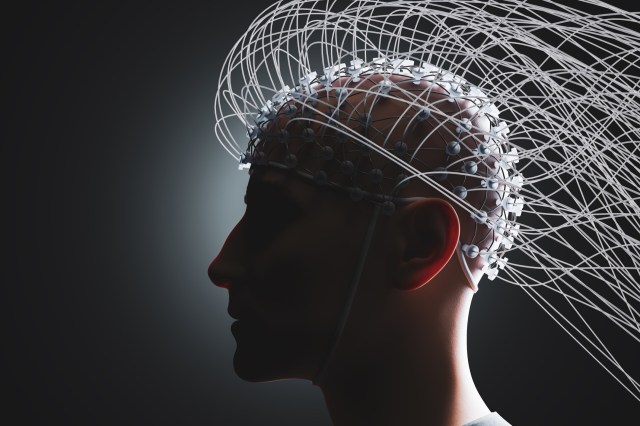
Megan Gardiner was 17 weeks pregnant when she died alone one June morning in 2022.
She had experienced her first epileptic seizure 12 years earlier, two days after her thirteenth birthday. “We heard a scream and then a loud bang,” says her mother, Alison Woolcock. “She’d collapsed on the landing. She was unconscious and shaking violently. After a couple of minutes she began to dribble, gasping for breath, and her whole face turned blue.”
This was followed by another, two weeks later, and many more in the following years. They were the most dangerous kind: what neurologists call generalised tonic-clonic seizures, which can be fatal.
As a teenager, Megan, who lived in Barry, near Cardiff, was prescribed a series of different drugs, but none of them worked. One in particular caused severe mood swings, when she would self-harm or exhibit uncontrollable rage. Sometimes she would have no seizures for a couple of weeks, but then have four in a single day. She had seizures at home, at school, out with friends and while swimming in the sea, when she was rescued before she drowned.
Eventually, when she was 15, her neurologist described a treatment that was highly effective at preventing generalised seizures — a cheap, easily manufactured drug called sodium valproate. But her parents were told their daughter could not be given it, despite the obvious risk to her life. Valproate, they were told, can cause birth defects — and therefore couldn’t be taken by Megan in case she decided to have a baby at some future date.
For Megan, the consequences were miserable. She couldn’t have a bath or cook a meal unless someone else was at home. Sometimes, unconscious during a seizure, she would urinate, and come round with no idea where she was. Fortunately, Alison stresses, she had friends and a loving partner who “accepted her seizures as part of who she was”. But every day, they knew, was a gamble.
On 4 June 2022, Alison called to Megan, then 25, through her bedroom door and didn’t get an answer. Thinking she might have gone out, Alison phoned her, but she didn’t pick up. She then texted Megan’s boyfriend and sister, asking if they knew her whereabouts: neither did.
Alison was reluctant to enter her daughter’s bedroom; years earlier, she had lost a daughter to sudden infant death syndrome, and was fearful of what she might find. Instead, she drove into town and looked for her, fruitlessly.
At last she went back home and into the bedroom. “First I saw her foot sticking out from the quilt, but most of her had fallen into a gap between the wall and the bed,” Alison says. “She was stuck there, and very clearly dead.”

***
Until now, media coverage of valproate has dealt with a single issue: the risk it presents to the unborn children of women who take it when pregnant. According to the Medicines and Health Products Regulatory Agency (MHRA), which licenses drugs and regulates them in Britain, roughly 11% of such babies are at risk of physical defects, such as cleft palate and spina bifida, and up to 40% may develop developmental disorders including ADHD and autism.
Even so, when it was first licensed in 1974, valproate was widely prescribed to pregnant women — some of whom were not informed of these risks. In 2022, The Sunday Times called this “a bigger scandal than thalidomide”. The BBC swiftly followed suit, and several law firms still offer to represent mothers who want to sue the NHS on a no-win, no-fee basis. In February, the Patient Safety Commissioner, Henrietta Hughes, published a report suggesting the government should set up a compensation scheme for those adversely affected by valproate.
Lost in this debate are some uncomfortable facts. Roughly 626,000 people in the UK have epilepsy, more than a fifth of whom experience generalised seizures, and for many thousands of them, valproate will be the only effective treatment. “If people are deprived of the most effective drug, some of them will die,” says Jane Hanna, policy director of SUDEP Action, which first predicted that restricting valproate’s use would cause excess deaths back in 2016, and has campaigned against this ever since. Today, SUDEP — sudden unexpected death in epilepsy — is responsible for some 600 deaths each year. A further 600 die from injuries caused by a seizure, such as falls, burns and drowning.
Faced with the negative publicity around the risk to children and threats of legal action, the MHRA has imposed a series of increasingly restrictive regulations. In 2018, for instance, it introduced the “pregnancy prevention plan” (PPP). Since then, all women below the age of 55 — including those who are celibate, single, lesbian, determined to be childless or below the age of consent — can only be prescribed valproate if they use “highly effective long-term contraception” such as the coil or a contraceptive implant, or agree to be sterilised.
“This is the antithesis to the normal position,” Paul Cooper, a consultant neurologist at Salford Royal Hospital, told me: “The life of a woman is being compromised for the sake of a possible future child.”
The latest rules, which came into force in January this year, introduced a further hurdle. Before anyone of child-bearing age can be prescribed valproate, two separate specialists must now “independently conclude and document that there is no other effective treatment” for them. If they are turned down, there is no right of appeal. Moreover, the new regulations also cover men, because the MHRA says taking valproate when a child is conceived may cause damage to sperm. This is despite the fact that new research suggests the evidence for this is incredibly weak.
Similarly, in recent months, a number of studies have indicated that withholding valproate is causing avoidable deaths. For example, a paper by six epilepsy experts published by the Journal of Neurology in June said the new regulations meant that “an estimated 21,000–28,000 people in the UK will imminently be exposed to the potential hazards of breakthrough seizures, including death”. Elsewhere, researchers at the University of Oxford found that between 2016 and 2020, instances of SUDEP among pregnant women and new mothers doubled. Another report last year said the increase had been sustained.
More recently, yet another new paper, in the October edition of Brain, examined the health records of thousands of patients who had been taken off valproate. It found statistically significant increases in “emergency department attendance, hospital admission, falls, injuries, burns and new-onset depression”. The five authors said epilepsy-related deaths also showed an increase, although they could not be sure this was statistically significant. However, they continued, such deaths were chronically under-reported, and required urgent investigation.
***
On 23 July 2022, less than two months after Megan Gardiner’s death, another woman from Barry, Paige Ellis, also died in her bed during a seizure. She was 23, six months pregnant, and already had a two-year-old son. Her partner told the local paper she had recently been given “new medication” which failed to control her frequent seizures. She was not taking valproate.
SUDEP, however, does not afflict only pregnant women. Like Megan, Emma Livie, 26, was prescribed various medications, none of which stopped the seizures — but never valproate. “It was never mentioned,” her mother Dianne says, “but I have no doubt she would have given it serious consideration.” But she was never given the choice, even after she had a series of violent seizures in 2019 known as status epilepticus, which can often lead to death. “She ended up on a ventilator, under a general anaesthetic, which was the only way to make the seizures stop,” says Dianne.
Emma was subsequently asked numerous times by doctors if she planned to get pregnant. “She told them she didn’t discount it permanently, but not for many years,” says Dianne, “she did have a boyfriend but their relationship had been rocky.”
Then, on 28 April last year, Dianne got no answer when she tried to phone her daughter: “I called the police, who broke down her door. Emma was in bed, her body stone cold. She’d died several hours earlier.”

It was only after Emma’s death that Dianne discovered the existence of valproate. “I was shocked,” she says. “From reading the academic studies, I think it would have stabilised her. But it was never discussed.” There is no suggestion that her doctors were negligent. But the effect of the national policy against using valproate with women of child-bearing age meant that “Emma’s medical team seemed more caught up in the fact that potentially she might have children one day than the risk to her life”.
The restrictions affect the living, as well as the dead. Faye Waddams, 38, who lives in Essex, had her first seizure when she was seven, but after being prescribed valproate, was seizure-free for years — until she was taken off it in 2009 because she had started to live with her now-husband. This was before the first MHRA regulations, but opinion was already hardening against allowing women who might have children to access to the drug.
Almost immediately, her seizures began again. She was prescribed five successive alternative drugs, but none was effective. One seizure occurred when she was 25 weeks pregnant, when she fell down her stairs. “They had to cut me out of my clothes,” she says. “I was strapped to a spinal board and blue-lighted to hospital. They thought I’d broken my neck.”
After Faye gave birth in 2015, the impact of trying to look after an infant while continuing to experience uncontrolled seizures was immense: “I couldn’t be left at home alone with the baby. I couldn’t drive or go out with him on my own. I felt trapped, frightened and helpless.”
She begged her doctors to put her back on valproate, but they refused, although she said she wanted no more children. Again, there is no suggestion of negligence: they were merely responding to the national policy guidance. But to Faye, “they were putting the interests of a hypothetical child who was never going to happen ahead of me and the child I actually had.”
Last year, Faye had a seizure at home, fell and broke her leg. In March, she finally found a medical team who agreed to prescribe her valproate: “It has transformed my life. I haven’t had a single seizure since I started taking it again.” She is now training to be a solicitor.
***
The UK is the only country in the world to impose valproate restrictions on men. The decision was taken in response to a Scandinavian study that indicated a possible link between male valproate use and an “increased risk of neurodevelopmental disorders in their children”.
Here, the MHRA admits that here “the causal role of valproate is not confirmed”, but didn’t want to take the risk. In response, 21 birth-defect experts from across Britain and Europe issued a paper describing the new rules as “premature”. The rules lately came under further attack in a study by seven neuroscientists in Melbourne. They concluded there was “no increased risk” for children conceived while their fathers were taking valproate, while the new restrictions were likely to lead to a rise in SUDEP.
Be that as it may, their impact has proven significant. There are no national data for valproate prescriptions, but figures presented to the NHS board covering Buckinghamshire, Oxfordshire and Berkshire in March showed there were only 571 women under 55 who were taking the drug but 2,769 men — all of whom now have to be assessed by two specialists and agree to abide by the MHRA’s belt and braces approach to contraception.
In other words, a neurology service that is already hard-pressed, with waiting lists of more than a year, must somehow conduct thousands of extra appointments, many with patients who have been happily taking valproate for years. Meanwhile, there is no established system to monitor the rules’ effects.
Marian Knight, the lead author of the University of Oxford’s surveys of maternal death, highlighted a further troubling issue. Obviously, if a pregnant woman dies, her baby will die too. But the oxygen starvation caused by seizures is also likely to harm a child: “Uncontrolled epilepsy is not good for a foetus,” Knight says. “Yet we have allowed the concern over birth defects to take precedence over all others.”
I asked the MHRA for an interview, but it declined. Instead, it issued a five-page statement by Dr Alison Cave, its chief safety officer.
According to Cave, the new regulations came into force because some women were still taking valproate during pregnancy, which required “further measures to minimise the serious harm from valproate in the exposed child”. (Last year, Hughes, the Patient Safety Commissioner, said there were still three babies being born each month to mothers who had been taking valproate.)
Cave also claimed there were “no data” linking the restrictions to increasing rates of SUDEP, a reference to the Brain study whose authors said they could not be sure the rise in deaths was statistically significant, while there was mounting evidence of “behavioural abnormalities” in children conceived by fathers who were taking valproate — by which she apparently meant the Scandinavian study that others have criticised.
Cave said that before imposing the new, 2024 regulations, the MHRA had “considered the views” of doctors and patient groups. However, SUDEP Action’s Hanna says there was “no consultation” with organisations representing patients before the decision was announced: “We were simply presented with a fait accompli”.
As for doctors, when the new rules were being discussed, the Association of British Neurologists wrote to the MHRA saying it feared they would lead to “unintended consequences such as death and morbidity through uncontrolled epilepsy”. It was ignored.
Cave insisted that the MHRA would be “closely monitoring the impact of the measures, including any unintended consequences”.
A good place to start might be the inquest into the death of Megan Gardiner, which will be held in Pontypridd next year. In September, I attended a preliminary hearing online, at which her family’s lawyers asked the coroner to rule that he should consider general issues around the use of valproate, and so draw conclusions of national significance. To her mother Alison’s dismay, this was successfully opposed by the NHS.
But she was allowed to address the court. “From the start, we have had to fight for the truth to come out,” she said. “We were always told that if she were a boy, there was a medication she could have — but she couldn’t in case she had a baby. But where was the thought for Megan in all this? Where was the thought for saving Megan’s life?”
To this, none of those present could provide an answer.
For confidential support and resources visit sudep.org










Join the discussion
Join like minded readers that support our journalism by becoming a paid subscriber
To join the discussion in the comments, become a paid subscriber.
Join like minded readers that support our journalism, read unlimited articles and enjoy other subscriber-only benefits.
Subscribe